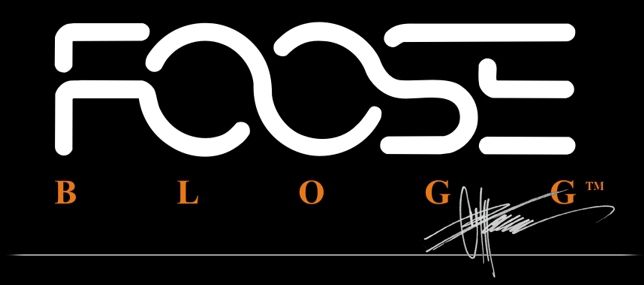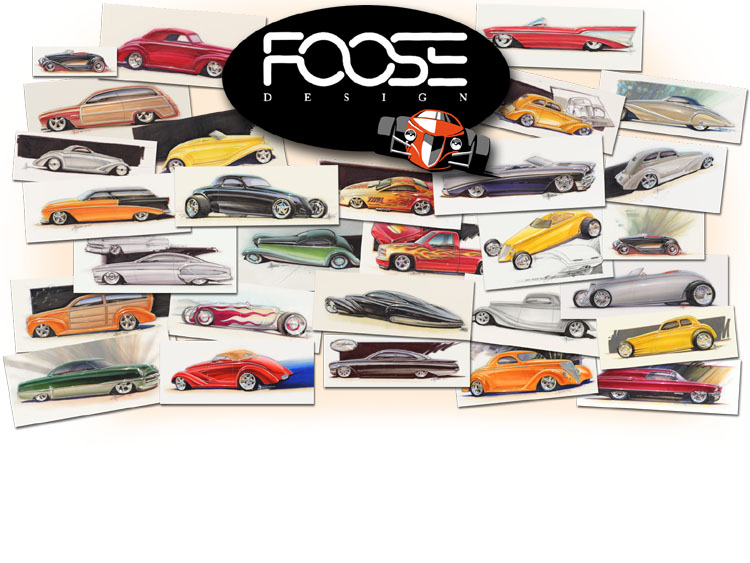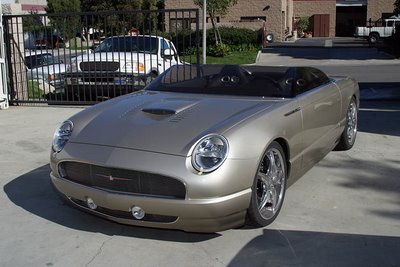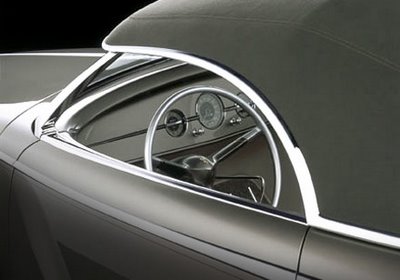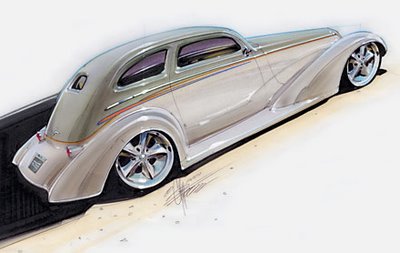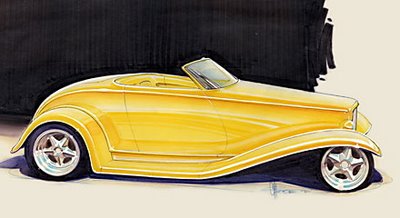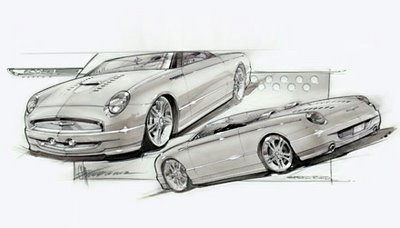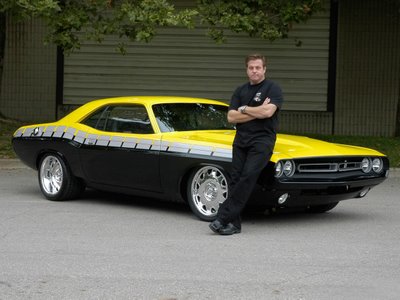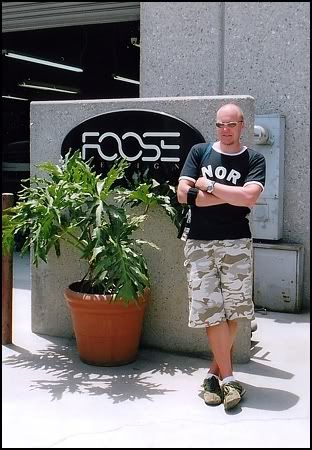
Deora Reborn
Even inside a darkened studio, the shape of the Nathan Proch designed Deora II is unmistakable. When power is sent to the overhead lights 30 feet above the studio's floor, the car is bathed in a soft glow. This image isn't easily forgotten. The same can be said for the time I spent with Hot Wheels designer Nathan Proch and car builder Chip Foose.
From concept to reality, the original Deora and the Deora II had similarities and fundamental differences. The original Harr Bradley/Alexander Brothers custom was born in the mid-1960s, and it was one of the first factory-backed showstoppers to tour the country on the custom car, rod and motor-cycle show circuit. It drew rave reviews from show goers and sparked the imaginations and passions of a new generation of car designers, among which were Proch and Foose.
In 1968, Mattel Toy Co. was preparing to launch a new line of miniature cars that would reflect the unique creativity of America's car culture. A few years earlier, Mattel founder Elliot Handler had wisely visited Detroit, the mecca of the American car industry. He lived and worked, however, in the Valhalla of automotive self-expression-Southern California.
The two cultures engendered many fertile minds, and Handler subsequently raided Detroit of designers Harry Bradley and Larry Wood. Already highly influenced by the SoCal, hot-rod styles, Bradley and Wood joined Ira Gilford and Howard Rees at Mattel. As a team, these men set out to create the first set of die-cast Hot Wheels. Of the 16 first releases, one was the Deora show truck. The Alexander Brothers, who had become friends with Bradley during his Detroit days, had originally constructed the Deora as a dream-car project for Chrysler. At that time, it was Bradley's creative mind and the A-brothers' talented hands that made the unique car possible.
Remaking a Legend
Meanwhile, Nathan Proch was a typical six-year-old growing up in the rural community of New Castle, Pennsylvania, 20 miles outside of Pittsburgh. Proch fondly recalls, "I was a young kid when Hot Wheels were launched. I was the target market. I was the guy they were trying to catch. And they [Hot Wheels] got me-they got me big time." Proch found great inspiration in the original Deora. "Growing up in New Castle, you don't do a lot of surfing. The Deora was my first exposure to a surf culture."
Indeed, the long liner form of the original Deora, much like the surfboards that Hot Wheels had mounted on its tonneau cover, made a lasting impression and inspired Proch greatly. "Everyone who looks at the Deora thinks "surfboards"-as if the vehicle were designed to hold boards-which it was not. So, when designing the Deora II, I wanted to keep the design true to Harry Bradley and Hot Wheels, [so] we had to have surfboards," Proch revealed. But Proch's approach for the Deora II's shape was inspired by the curved, aqua-dynamic design of the boards used by today's surfers rather than the long, flat boards ridden by surfers in the 1960s.
Looking at the visual dynamics of the vehicle you will see Proch's mastery of combining the flat tonneau surface on top with the wave-like undulations of the lower body line. "The shape expresses the liquid element that is water," he explains. The stunning blending of machine and nature gave the car a haunting attraction, but the signature Hot Wheels muscle icon also had to be part of the design.
As a Hot Wheels guy, you have to address the engine. This is the symbol of power, and that has to be visually demonstrated," Proch explains with a glint in his eye. The idea was that car nuts, young and old, are drawn to the power source, thus the engine needed to be visible. In keeping with the Hot Wheels heritage, he knew the power should be provided by an American V-8, and that it needed a blower (supercharger). But because this was a modern reincarnation, Proch required that the D-II demonstrate current technology. Therefore, he inked the vehicle with a transverse-mounted Cadillac Northstar engine in the rear.
Proch was on a roll, but something was missing. Sure, the tires and wheels were monstrous, the styling highly progressive and the features over-the-top, but the last piece of the puzzle had yet to be integrated with the emerging whole. He put the drawing aside for a few hours, and when he returned to his studio, it hit him. "The rule of today is that every cool car has a rear-deck wing. Functional or not, spoilers are everywhere." The genius of his design presented Proch with his biggest challenge-to style a wing that complemented the shape of the D-II without taking away from its other remarkable features.
Indeed, Proch found inspiration from another icon of Southern California industry-aerospace. He explains his revelation: "The wing actually curves forward. I have never seen another [car] wing that curves forward into the wind. In an era where we have jet planes with forward sweptwings, I wondered, 'Why can't we do the same with automotive design?'"
Hitting the Big Time
eeing the Hot Wheels Deora II sitting on a toy-store shelf, you can't begin to appreciate the complexity of its design and the spirit that Nathan Proch engineered into it. Much like its predecessor, the contemporary version created a buzz in the die-cast world, but, quite unlike the original, this version was intended only for small scale. When the idea of turning this Rembrandt into a full-scale version was first discussed, it presented an entirely new set of challenges.
Nearly all die-cast cars begin life in 1:1 and are miniaturized until the desired dimensions are reached. The Deora II, however, was created in reverse, just as the full-scale Twin Mill that was built for Hot Wheels' 30th anniversary had been. The primary difference was that simply enlarging the scale of a Hot Wheels model to its 1:1 counterpart presented a bundle of problems, the most notable being the size and function of the tires and wheels.
When Mattel took on the task of creating a full-scale version of the Twin Mill, it turned to custom-car legend Chip Foose. Faced with the complexities of bringing the Deora II to life, Mattel once again sought out Foose and his band of manic machinists. "From the popularity of that car [Twin Mill] after it was resurrected and put on the show circuit, we [Mattel] knew the excitement of having Chip work on it. When this project came along for the 35th anniversary, it was only natural to go back to Chip," explained Mattel's Carson Lev.
Time, or the lack of it, presented Foose with the first major hurdle. "The time schedule on this project was unbelievably aggressive. I don't know of anyone else who could have pulled this off," said Lev. Twenty-four weeks was all the time the Foose team had to work with. In that time, they had to scratch-build Nathan Proch's dream machine. With funding from Mother's Wax, Foose was able to employ the talents of other top-level customizers to fast-track the project.
Few people in the automotive world are as passionate and as driven as Chip Foose. "There have been days or even a week that goes by where I get very little sleep in an effort to complete a car," admits Foose. "It's not that the car is important-it's not. What's important are friendships and my word. If I say I'll get it done, it will get done."
When the time came to begin the Deora II's life-size buildup, Foose started with a Cadillac Deville DTS. The front clip of the front-wheel-drive car was torn completely away from its platform. "The DTS was selected because we could take a front-wheel drivetrain and make it the back," Foose explains. "We now had the transaxle in place; all we needed to do was lock the steering." It sounds easy-yeah, right. Imagine the car with all of its electronics carefully pulled from its termination points and draped over the engine. "I didn't want to cut any wires. From there, it took about six weeks to build the entire rolling chassis," Foose recalls.
Unlike the original Deora-made from a Dodge A-100 pickup-the D-II body bore no resemblance to any modern car or truck. The body, therefore, had to be hand-crafted or formed, so Foose employed the talents of the Five Axis crew. Using digital data, a female mold was made to lay up the body in fiberglass. The body was then dropped over the chassis to determine the positions of the mounting points, the functional components and the accessories. As the body was being prepared for finishing, Foose's team of builders and the Five Axis team went about the task of constructing the D-II in the same way as they had built dozens of street rods and wild customs. Meticulous attention to detail was taken to ensure that the now grown-up die-cast could actually be driven.
The Start of Something Big
On November 11, 2003, after 24 weeks of Foose and his team's furious fabricating, the Deora II was ready for its breakout party. At the opening of the Hot Wheels Hall of Fame at the Petersen Automotive Museum in Los Angeles, television star and renowned car collector Jay Leno fired up the Proch-designed, Foose-built Deora II and drove it into the star- studded gala event.
Under an agreement with Mother's Wax, The Deora II was used in a series of promotional events to highlight the company's line of premium car-care products. In May 2004, Mattel moved the vehicle to the Petersen Automotive Museum, where it is now united with the original Deora and the full-size Twin Mill as part of the Hot Wheels Hall of Fame exhibit.
To date, the Twin Mill and the Deora II are the only drivable, full-scale cars that originally started as die-cast models. As Hot Wheels' 40th anniversary approaches, however, there's no telling what Mattel might bring to life. As Nathan Proch sharpens his pencils, Foose is clearing shop space. When these two worlds collide, anything can happen.

